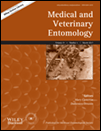View Item
- xmlui.general.dspace_homeCentros Regionales y EEAsCentro Regional Santa FeEEA RafaelaArtículos científicosxmlui.ArtifactBrowser.ItemViewer.trail
- DSpace Home
- Centros Regionales y EEAs
- Centro Regional Santa Fe
- EEA Rafaela
- Artículos científicos
- View Item
Ecological characterization of a tick community across a landscape gradient exhibiting differential anthropogenic disturbance in the Atlantic Forest ecoregion in Argentina
Abstract
An ecological analysis of a tick (Ixodida: Ixodidae) community across a landscape gradient presenting differential anthropogenic disturbance in the Atlantic Forest ecoregion in Argentina was performed. Ticks were collected from vegetation and hosts between September 2014 and August 2016. A total of 12 697 free‐living ticks and 3347 specimens from hosts were collected, including 317 ticks infesting humans. The values obtained show considerable species
[ver mas...]
An ecological analysis of a tick (Ixodida: Ixodidae) community across a landscape gradient presenting differential anthropogenic disturbance in the Atlantic Forest ecoregion in Argentina was performed. Ticks were collected from vegetation and hosts between September 2014 and August 2016. A total of 12 697 free‐living ticks and 3347 specimens from hosts were collected, including 317 ticks infesting humans. The values obtained show considerable species diversity in the forest environment accompanied by low equitability. The similarity index derived from a comparison of forest and agricultural environments was higher than that calculated by comparing forest and urban environments. The data suggest that although a cycle of one generation per year is apparent in some species, more than one cohort may co‐exist within the populations of some of these species. Well‐marked patterns of the seasonal distribution of free‐living tick species emerged in environments with no anthropic modification. The results indicate that forest environments are more suitable habitats than agricultural and urban environments for many species of native tick, but are unsuitable for exotic species that have successfully established in environments that have been modified by man.
[Cerrar]

Author
Lamattina, Daniela;
Venzal, José Manuel;
Costa, Sebastián Andrés;
Arrabal, Juan Pablo;
Flores, S.;
Berrozpe, Pablo Eduardo;
González-Acuña, Daniel;
Guglielmone, Alberto;
Nava, Santiago;
Fuente
Medical and veterinary entomology 25 January 2018
Date
2018-02
ISSN
0269-283X
1365-2915
1365-2915
Formato
pdf
Tipo de documento
artículo
Palabras Claves
Derechos de acceso
Restringido
 Excepto donde se diga explicitamente, este item se publica bajo la siguiente descripción: Creative Commons Attribution-NonCommercial-ShareAlike 2.5 Unported (CC BY-NC-SA 2.5)
Excepto donde se diga explicitamente, este item se publica bajo la siguiente descripción: Creative Commons Attribution-NonCommercial-ShareAlike 2.5 Unported (CC BY-NC-SA 2.5)

